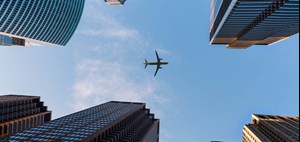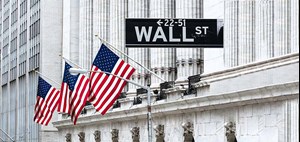Bears take a breather as Fed considers reducing hiking pace as growth slows
Having endured a difficult first half of the year, global equity markets recovered some lost ground during the month as the MSCI All Country World Index, a broad measure of global equity markets, gained 7% during July. Investor confidence has been boosted by companies reporting better than expected results, for the most part at least, along with expectations that the US Federal Reserve (“Fed”) may slow the pace at which it is hiking interest rates as economic growth continues to slow.
Economic data shows that US GDP for the second quarter of 2022 contracted by 0.9% on an annualised basis. Output declined 1.6% in the first quarter of the year and for some, consecutive declines can be interpreted as the US entering a recession, at least on a technical basis. Others however do not feel that the US has entered a recession for a number of reasons. The US labour market continues to show growth in job numbers and consumers as well as the private sector remain stable despite visible signs of strain from soaring inflation.
The decline in economic growth does however complicate matters for the Fed as it seeks to tame rampant inflation through the process of increasing interest rates. During July the Fed implemented its second 75-basis point increase in as many months following economic data that showed US consumer prices rose by 9.1% during June, higher than the predicted 8.8% and the largest increase in forty years. While raising interest rates may have the desired effect of reducing consumption and ultimately inflation, it could also have the undesirable consequence of reducing economic growth in an environment already experiencing a slowdown.
This could be the reason behind Fed chair, Jay Powell, commenting on the possibility that the Fed may begin to slow the pace at which they are increasing interest rates. Stocks rallied on a potential slowdown in interest rate increases with the S&P 500 Index eventually ending the month 9% higher. Longer duration stocks, those whose valuations are relatively more sensitive to changes in interest rates such as technology stocks, saw even bigger gains during the month with the tech-heavy Nasdaq gaining over 12%. It should be noted that while Mr. Powell said a slowdown in rate hikes by the Fed is possible, he also mentioned that the Fed might implement another sizable increase at the next meeting which is scheduled for September.
Despite the Fed continuing to hike interest rates, the benchmark yield for the US 10-year Treasury has continued to trend lower since peaking at nearly 3.5% last month. Equity markets may have staged a recovery during July but are still down sharply year-to-date. An extended period of falling stock prices, elevated market volatility and a slowdown in economic growth have led to increased demand for safe haven assets, specifically the US dollar, which has in turn placed downward pressure on bond yields – bond yields fall as their prices increase. The longer-term 10-year yield ended the month at 2.64% and is now below its shorter-term counterpart, the US 2-year, which closed July at 2.90%. Typically, longer-term yields are higher than the short-term but a scenario such as we are seeing now, which is referred to as an “inverted yield curve”, portends to a possible recession as interest rates are typically reduced during a recession to help stimulate economic activity. As an aside, gold, an alternative safe haven asset continues to trade below $1,800/ozt. The yellow metal fell 4% during month as the US greenback remains the preferred safe haven destination, for now.
US equity markets were also boosted during the month by companies reporting better-than-expected results though the impact of higher inflation has begun to filter through into their numbers. Big retailers and banks have seen a reduction in consumer spend in many discretionary categories in favour of groceries and fuel. The invasion of Ukraine by Russia has led to substantial price increases in many commodities, especially food and energy, as their supply has deteriorated. While commodity prices in these areas remain elevated, they did soften somewhat during July. Grain prices declined following the relaxation of the Black Sea blockade by Russia which allowed the first shipment since February to leave the Ukrainian port of Odessa. Despite the imposition of sanctions on Russian oil by Western nations, fears of a global slowdown which could lead to a contraction in oil demand saw the price of Brent crude fall 8% during the month closing the period at $110 a barrel.
The US dollar reached a two-decade high against other major currencies with the euro in particular continuing to fall. Destabilising factors in the region continue to mount such as two Prime ministers, the UK’s Boris Johnson and Italy’s Mario Draghi, saying “Hasta a vista, baby” to their positions and European economies such as Germany, who are heavily reliant on Russia for energy needs, having their economic growth forecasts slashed as Russia ratchets down its supply of gas. Lest not forget to mention that inflation across the continent continues to trend well above 8%.
Unlike many other central banks that had begun raising interest rates to tackle soaring inflation, the European Central Bank (“ECB”) had to date kept its powder dry though it had more recently turned somewhat hawkish in its stance. Markets were therefore somewhat surprised when the ECB did raise interest rates for the first time in eleven years, not so much by the action but rather the quantum, as it raised rates by a full 50 basis points. This was greater than the expected 25-basis point increase and meant that for the first time in nearly eight years, European deposit rates were no longer negative.
A larger than expected rate hike by the ECB and a downgrade in forecast economic growth rates for the region did not prevent European equity markets from gaining during the month. It would not be out of line to assume that some of the gains seen in European stocks can also be attributed to the decline in bond yields. Similar to the US, longer-term European bond yields have fallen, perhaps indicating investor expectations of an economic slowdown, at best, or more likely a recession in the European region. In descending order, we saw gains in the following European indices: the Netherlands AEX (+11%), French CAC 40 (+9%), German DAX (+6%) and UK FTSE 100 (+4%).
As investors continue to pour funds into the US dollar so do funds continue to flow out of emerging markets. This could be a contributing factor behind emerging equity markets lagging behind their developed market counterparts. The JSE All Share Index was no exception to the trend underperforming on a relative basis though it still managed to gain over 4% during the month (in USD terms the gain was a little over 2%). The standout contributor during the month was luxury goods group Richemont as it reported better-than-expected sales growth despite the impact of lockdowns in China.
South Africa has not been immune to inflation pressures as June CPI showed a 7.4% year-on-year increase in consumer prices, rising above the 6.5% increase recorded a month earlier. Inflation for producers was even higher as Producer Price Inflation or PPI showed a year-on-year rise of 16.2% during June. In line with the Fed, the South African Reserve Bank also raised interest rates by 75 basis points in an attempt to cool down rising prices. The Prime rate of interest now stands at 9.0%.
As far as emerging markets are concerned, it was an especially challenging month for Chinese equities. A fresh wave of lockdowns were implemented across various districts as the Omicron subvariant continues to spread. Lockdowns in China have wreaked havoc on the country’s economic activity as reported figures show that China barely managed to eke out a gain for the second quarter of 2022, with the economy only growing at 0.4%, the lowest growth in three decades. Making matters worse has been the ongoing concern surrounding the country’s property sector. Real estate accounts for roughly one third of China’s output and when one of China’s largest property developers recently defaulted on its debt, alarm bells began to ring. Investor concern has deepened following Chinese property buyers threatening to stop paying mortgages on uncompleted apartments should construction by property developers grind to a halt. Stock prices did however receive a boost on news that banks would help finance the property developers, following prompting from Beijing authorities. Despite the positive news, Chinese equity markets ended the month in the red as both the mainland CSI 300 Index and Hong Kong’s Hang Seng Index fell by over 6%.






